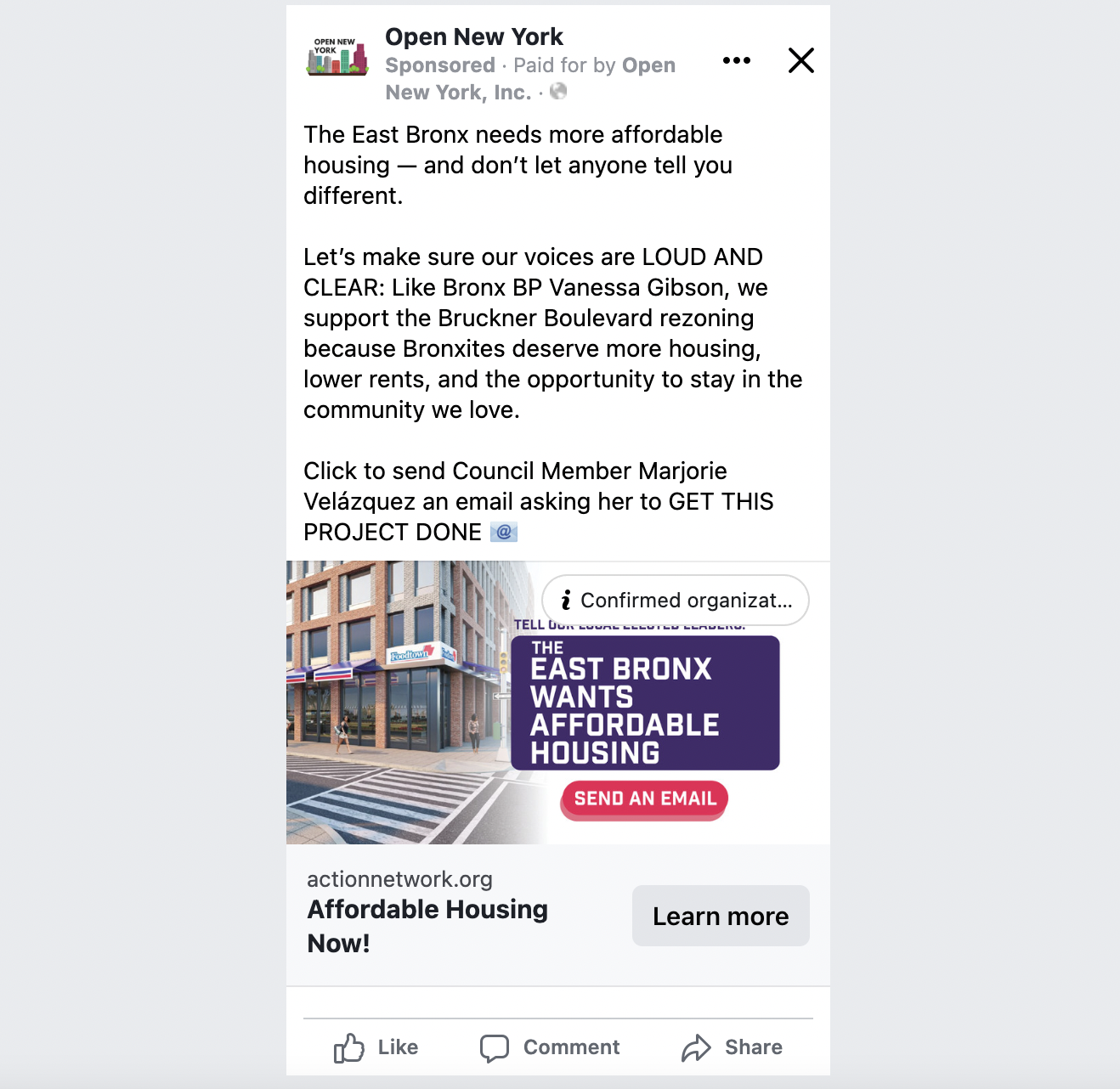The fight over a proposed housing development in Throggs Neck is heating up, with a prodevelopment group launching a five-figure ad campaign calling on the local City Council member to support the project.
Open New York has targeted the campaign at Council Member Marjorie Velázquez, a freshman member of the council who represents Throggs Neck and other parts of the East Bronx. The ads – digital and in print in The Bronx Times, in English and Spanish – call for Velázquez to support a rezoning proposal on Bruckner Boulevard that would allow new housing development spread over four sites, including 99 permanently affordable units under the city’s Mandatory Inclusionary Housing program and 99 units designated for seniors. The project is proposed by a group of developers that includes the owners of a local Foodtown, and would include an updated grocery store.

The project would include about 349 apartments in all – including in two eight-story buildings – and has been met with sharp opposition from the local Community Board 10 and some residents who want to maintain the area’s low-density zoning. Some residents have argued that the area doesn’t have the infrastructure to support that many additional families, and some have raised concerns that their property values will plummet as taller buildings go up around them. The saga, which has been followed closely by local outlets like The Bronx Times, reached its next stage on Wednesday as the City Planning Commission voted to send the proposal on to the City Council for consideration and an eventual vote.
Velázquez, who was endorsed by Open New York as a “housing champion” in 2021, is already on record as opposing the project. She reaffirmed her position this week. “Right now, my community is against it, and it’s very clear that they’re against it,” Velázquez told City & State. Velázquez said her primary concern was that the area does not have the infrastructure – including reliable transit service, education and sewer system – to support the addition of hundreds of new families to the area. “The community is not against development,” she said. “They’re saying, ‘Develop within the zoning that is allowable.’”
Residents of the area have also vocally opposed a city proposal to build studio apartments for people formerly incarcerated at Rikers at Jacobi Hospital in Morris Park. Velázquez told the New York Post she hoped “to find a use for the building that works for the community, patients, and the hospital.”
Throggs Neck, along with Staten Island, was designated in 2004 as a Lower Density Growth Management Area, putting restrictions on residential development in the neighborhood in an effort to maintain the area’s suburban character and prevent overcrowding. But groups like Open New York argue that the restrictions inhibit sorely needed housing production, including affordable units. According to a May report by the New York Housing Conference, Velázquez’s 13th Council District ranks in the bottom five of council districts for the production of new affordable housing since 2014.
Logan Phares, the political director of Open New York, said that she believes the voices speaking up against the proposed rezoning don’t represent the whole of the community. “They are committed to the status quo, which we know is not workable in New York City anymore,” Phares said. “We think that there are more folks who want to build more housing, more affordable housing, in the neighborhood than there are opponents.
The opposition to this project has so far dealt more with objections to upzoning at all than with dissatisfaction about the number of affordable units or level of affordability included – which was one of the primary concerns about One45 proposed development in Council Member Kristin Richardson Jordan’s Harlem district earlier this year. But Velázquez said affordability is on her mind too. “The fear of displacement is very, very real to begin with,” she said. “You’re adding the fact that you’re talking about less than a third (of units) being affordable, then what are you really offering my community?” According to the City Planning Commission, rent for the designated affordable units in the Bronx rezoning proposal would average out at 80% of the area median income.
The project does have support from Bronx Borough President Vanessa Gibson – with some conditions, including that one of two proposed eight-story buildings be reduced to five stories. Still, thanks to the tradition of member deference in the City Council – the body’s tendency to align with the local member’s position on land use matters – it’s Velázquez’s support that’s key. Velázquez did not specify whether there are changes to the proposal that could be made to win over her support, but said she wants to hear more from the developers at a City Council hearing about what kind of engagement they’ve had with the community.
That’s not to say that approval of the project is impossible without the local member’s support, as deference is an unofficial tradition, not a rule. Late last year, the council defied that tradition to approve the expansion of the New York Blood Center on the Upper East Side, despite then-Council Member Ben Kallos’ opposition.
If he chooses to get involved in support of the project, the Throggs Neck rezoning fight could be an opportunity for Mayor Eric Adams to throw some weight around in the Council. “As an organization we’re in constant communication with the administration, and we have things we bring up, and this is one of them for sure,” Phares said of the Throggs Neck rezoning.
NEXT STORY: The August primary endorse-o-meter


